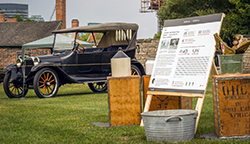First World War Comes To Life exhibit visits Fort York
 Vintage 1917 Triumph Model H Motorcycle at Fort York. Photo by Claudia Gaboury
Vintage 1917 Triumph Model H Motorcycle at Fort York. Photo by Claudia Gaboury First World War medical aid station exhibit with 1917 Dodge Red Cross Sedan. Photo by Claudia Gaboury
First World War medical aid station exhibit with 1917 Dodge Red Cross Sedan. Photo by Claudia Gaboury
First World War Comes to Life brought their travelling exhibit of Great War service vehicles to Fort York on Aug. 8 & 9. This is the largest private collection of operational First World War vehicles in Canada, focusing on how mechanization and transportation changed the nature of war.
Visitors to the exhibit were greeted by service vehicle and military interpreters from both Fort York and First World War Comes to Life. They enthusiastically answered myriads of technical and human interest questions and helped bring to life the men and women who used these vehicles and the roles they played in the war effort. Unlike many static museum displays, all of the First World War Friends of Fort York guardsman Pierce Cosgrove (left) and Fort York Program Development Officer Kevin Hebib (right), are seen on the 1917 Douglas with sidecar. Beautifully restored in the royal blue colour of The Royal Flying Corps. Photo by Ted Smolak Comes to Life vehicles are in working order and a number of trucks, sedans and motorcycles were driven around the Fort York parade ground during the two day exhibit. Seeing a 1917 Dodge sedan hand cranked and hearing the engine sputter to life, was a delightful experience that few visitors had witnessed before. Each exhibit vehicle is now approximately 100 years old and has its own unique story of service and survival. For instance, the rare and recently restored 1917 portable field kitchen was found after languishing for many years on an Alberta ranch. Motorcycle enthusiasts were particularly interested to see working examples of the Trusty Triumph, Douglas and Harley motorcycles. They are rare survivors from a time when motorcycle design was in its infancy. Women, as interpreted in the field ambulance exhibit, made significant social gains through their work overseas as medics, ambulance drivers and motorcycle dispatch riders. When the war was over, few wanted to return to their former Edwardian-era society roles. Saturday’s event also included a unique flypast above Fort York by four aircraft from the The Great War Flying Museum including the Fokker Dr.I Triplane, Nieuport 28, Sopwith 1½ Strutter, and Royal Aircraft Factory S.E.5a. The flight display further demonstrated how quickly mechanization had conquered land, sea and air.
Friends of Fort York guardsman Pierce Cosgrove (left) and Fort York Program Development Officer Kevin Hebib (right), are seen on the 1917 Douglas with sidecar. Beautifully restored in the royal blue colour of The Royal Flying Corps. Photo by Ted Smolak Comes to Life vehicles are in working order and a number of trucks, sedans and motorcycles were driven around the Fort York parade ground during the two day exhibit. Seeing a 1917 Dodge sedan hand cranked and hearing the engine sputter to life, was a delightful experience that few visitors had witnessed before. Each exhibit vehicle is now approximately 100 years old and has its own unique story of service and survival. For instance, the rare and recently restored 1917 portable field kitchen was found after languishing for many years on an Alberta ranch. Motorcycle enthusiasts were particularly interested to see working examples of the Trusty Triumph, Douglas and Harley motorcycles. They are rare survivors from a time when motorcycle design was in its infancy. Women, as interpreted in the field ambulance exhibit, made significant social gains through their work overseas as medics, ambulance drivers and motorcycle dispatch riders. When the war was over, few wanted to return to their former Edwardian-era society roles. Saturday’s event also included a unique flypast above Fort York by four aircraft from the The Great War Flying Museum including the Fokker Dr.I Triplane, Nieuport 28, Sopwith 1½ Strutter, and Royal Aircraft Factory S.E.5a. The flight display further demonstrated how quickly mechanization had conquered land, sea and air.
For more information about both organizations and upcoming events, check the First World War Comes to Life website http://www.firstworldwarcomestolife.org and The Great War Flying Museum http://greatwarflyingmuseum.org/